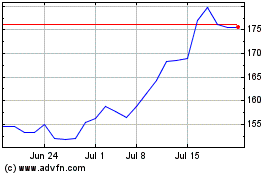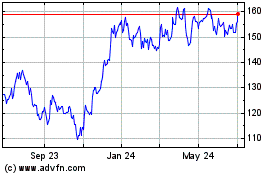Online Bank Accounts With High Interest Rates Could Lose Some of Their Shine
September 16 2019 - 8:29AM
Dow Jones News
By Allison Prang
Big banks bet that online savings accounts would help them bring
in customers when rates were rising. Now that rates are falling,
that growth may stall.
Many banks started offering these accounts -- which often paid
interest rates of at least 2% -- in the past couple of years to
attract depositors. But some of those lenders, including PNC
Financial Services Group Inc., Citizens Financial Group Inc. and
CIT Group Inc., have recently started trimming their deposit
rates.
Banks have broad latitude over what they pay on deposits, though
they tend to move interest up and down as the Federal Reserve
adjusts rates. Banks often are quicker to cut deposit rates than
they are to raise them. Banks including Goldman Sachs Group Inc.
and Ally Financial Inc. recently cut their deposit rates even
before the Fed did.
The Fed lowered short-term rates by 0.25 percentage points this
summer -- its first rate cut in a decade -- and it could cut rates
again this month. If it does, banks could be more inclined to keep
lowering their deposit rates. The trend marks a reversal from a
year ago, when the Fed was still raising rates and many bankers
expected the rate increases to continue through this year.
CIT, the parent company of California-based OneWest Bank, last
year introduced a high-yield savings account, Savings Builder, that
promised customers higher interest rates if they saved at least
$100 a month or had at least $25,000 in their account.
CIT has lowered the rate it pays on the higher tier of that
account three times since May. The current rate is 2.2%, down from
2.45% before those three cuts. Deposits for the company's direct
bank, which includes those accounts, grew at a slower pace in the
second quarter compared with the first quarter.
Citizens launched its Citizens Access high-yield savings account
last year. It lowered the rate on that account in July and then
lowered it by an additional 0.2 percentage points this month to
2%.
Citizens CEO Bruce Van Saun said in an interview in mid-July
that the flow of new money into those accounts could slow if the
Fed cuts rates more than twice. The central bank did that for the
first time in this cycle shortly afterward.
Banks tweak interest rates to balance two different needs: They
want to attract and retain customer deposits, but they don't want
to pay more than customers demand. Banks make money on the
difference between what they charge on loans and what they pay on
deposits.
PNC lowered the rate on its online savings account by 0.2
percentage points in late August to 2.15%.
"If you post in the top couple rates, you gather lots of
deposits," CEO Bill Demchak said on the company's earnings call in
July. "If you're off that frontier, it slows down."
But those accounts still pay better rates than many lenders.
Andrew Frisbie, executive vice president for consumer pricing at
consulting firm Novantas, said the central bank would need to cut
rates by something like 1.5 percentage points for customers to
potentially lose interest in moving their money into these
offerings.
To receive our Markets newsletter every morning in your inbox,
click here.
Write to Allison Prang at allison.prang@wsj.com
(END) Dow Jones Newswires
September 16, 2019 08:14 ET (12:14 GMT)
Copyright (c) 2019 Dow Jones & Company, Inc.
PNC Financial Services (NYSE:PNC)
Historical Stock Chart
From Mar 2024 to Apr 2024

PNC Financial Services (NYSE:PNC)
Historical Stock Chart
From Apr 2023 to Apr 2024
